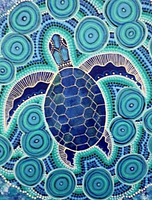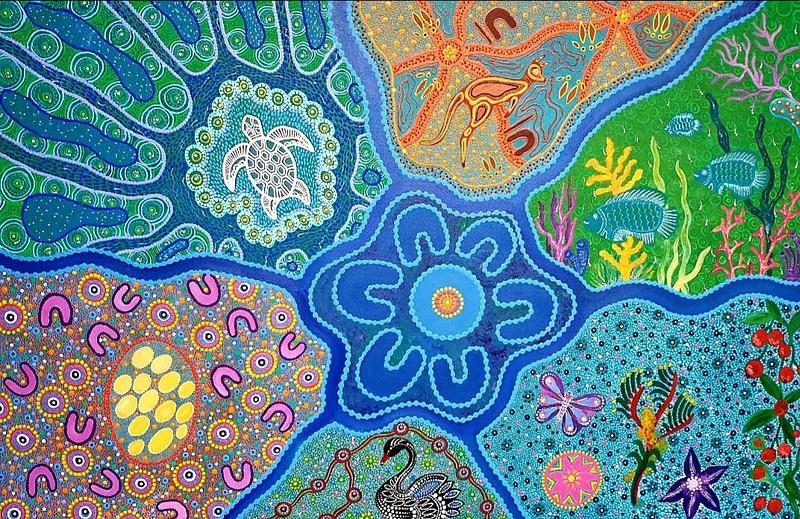Noongar Seasons
Noongar Seasons
Pre order your print of original art work
The Noongar Seasons:
Birak - First Summer - December to January- During Birak the rain eases and the weather becomes hot and dry, afternoons are cooled by the sea breeze. Traditionally Birak was the fire season for Noongar people to initiate controlled burning to regenerate the land. Controlled sectional burning helped seed germination, forced animals out of the scrub making it easier to hunt. Made easier access moving across the land. Birak sees many young birds venturing out of their nests, some staying close to their parents. Reptiles start shedding their old skins for a new skin, baby frogs complete their transformation into adulthood. Birak is also known as the Season of the Young.
Bunuru – Second Summer - February to March - Bunuru is the hottest part of the year with little to no rain and hot easterly winds with a cool sea breeze in the afternoon. Noongar people lived along the coast, rivers and estuaries and their diet consisted mainly of freshwater and seafood. Bunuru is a time of the white flowers in bloom especially Jarrah, Marri and Ghost Gum. Also a time to look out for the female Zamia (Macrozamia Riedle) a much larger plant than its male counterpart, the huge cones emerges from the centre of the plant with masses of cotton wool like substance. As the hot and dry weather continues the Zamia seed cones change colour from green to bright red indicating they are ripening and becoming more attractive to animals, particularly the emu, that will eat the toxic fleshy out layer of the plant. Bunuru is also known as the Season of Adolescence.
Djern – Autumn - April to May - Djern season sees a break in the hot weather, it is the beginning of cooler nights that bring a dewy presence in the early mornings. The winds change to light breezes. Flying ants can be seen flying in the light southerly winds. Djern season sees red wildflowers taking bloom especially the Red Flowering Gum (Corimbiaficifolia) and the petit Summer Flame (Beaufortia Aestiva). The Sheoaks tree (Allocasuarina Fraseriana) form cones and the Banksia start to display their flowers ensuring the nectar from the flower is a source for many small mammals and birds. Traditionally, foods at this time of the year including the Zamia seed had been collected placed in fresh water and dried out a season earlier, as well as root bulbs of the Yanget (Bullrushes) freshwater fish, frogs and turtles. As the season progresses the nights become cooler and damp, the onset of cooler and cold weather meant traditionally Noongar people would start to prepare their Mia Mia (homes and shelter) for heavier rains in the coming winter months. Djern is also known as the Season of Adulthood.
Makuru – Winter - June to July - Makuru is the coldest and wettest time of the year. Traditionally Makuru was a good time to move back inland away from the coast. Winds turned to the west and south bringing the cold weather, rain and occasional snow on the peaks of the Stirling and Porongurup Ranges. During Makuru the waterways begin to fill, and Noongar peoples diet changed from water and seafoods to hunting kangaroo, kangaroo provided a food source and the bookas (animal skin cloaks used for the cooler nights). Makuru is also a time of year for a lot of animals to begin pairing up in preparation for breeding in the coming season. Wardongs (crows/ravens) can be seen flying together during this season, upon the rivers and lakes of the South-West you will notice the influx of the Maali (Black Swan) as they prepare to nest and breed. Blue and purple flowers start to emerge, this includes the Blueberry Lilly (Dianelle Revoluta) and the Purple Flags (Patersonia Occidentalis). As Makuru season ends, you will notice the white flowers of the weeping Peppermint Tree (Agonis Flexuosa) as the blues start to make way for the white and cream flowers of Djilba. Makuru is also known as the Season of Fertility.
Djilba – First Spring - August to September - Djilba season is the start of the massive flowering explosion in the South-West. It begins with the yellow flowering of the Acacias, you will notice cream and striking blue coloured flowers, as the temperatures continue to rise you will see the flower stalks of the Balga Bush (Grass Tree) emerge in preparation for the coming Kambarang Season. Djilba is a traditional time of the year that has very cold and clear days, some that rainy and windy mixing with the occasional sunny day. As the days start to warm up you will start to see and hear the first of the newborns with the parents providing them with food, shelter and protection from larger animals including people. Traditionally the main food sources at this time of year included the Yonga (kangaroo) Waitj (emu) and Koomal (possum). The woodland birds will still be nest bound, hence the swooping behaviour of the Koolbardi (magpie) Djidi Djidi (willywag tail) and the Chuck-a-luck (wattle birds). Djilba is also known as the Season of Conception.
Kambarang – transformational time of the year - October to November - Kambarang is the wildflower season, we see an abundance of yellow flowers, orchids, kangaroo paws and banksias, the Balga Bush will flower especially if they have been burnt or closely shaved in the past year. One of the most striking flowers at this time of the year is the Moojar the Australia Christmas Tree (Nuytsia Floribunda) the bright orange and yellow flowers signal the heat is on its way. Kambarang season October is the time of the year where you are more likely to encounter snakes awaking from hibernation and make the most of the warmth to assist them getting enough energy to look for food. Many things are undergoing transformation with the longer warmer and dry days.
Size - W60cm x L90cm x H3cm
*Pre Orders - Allow 4 - 8 weeks
*Free delivery Perth Metro area only!








